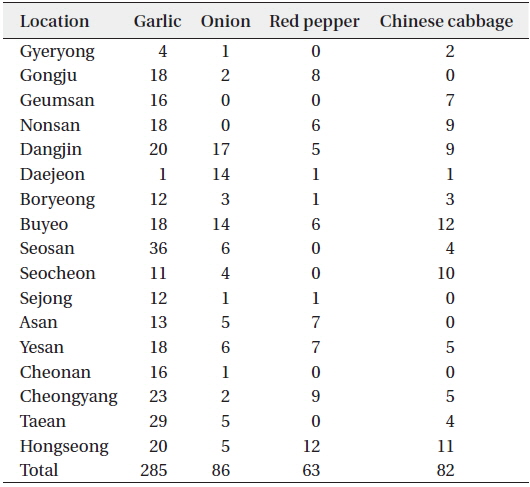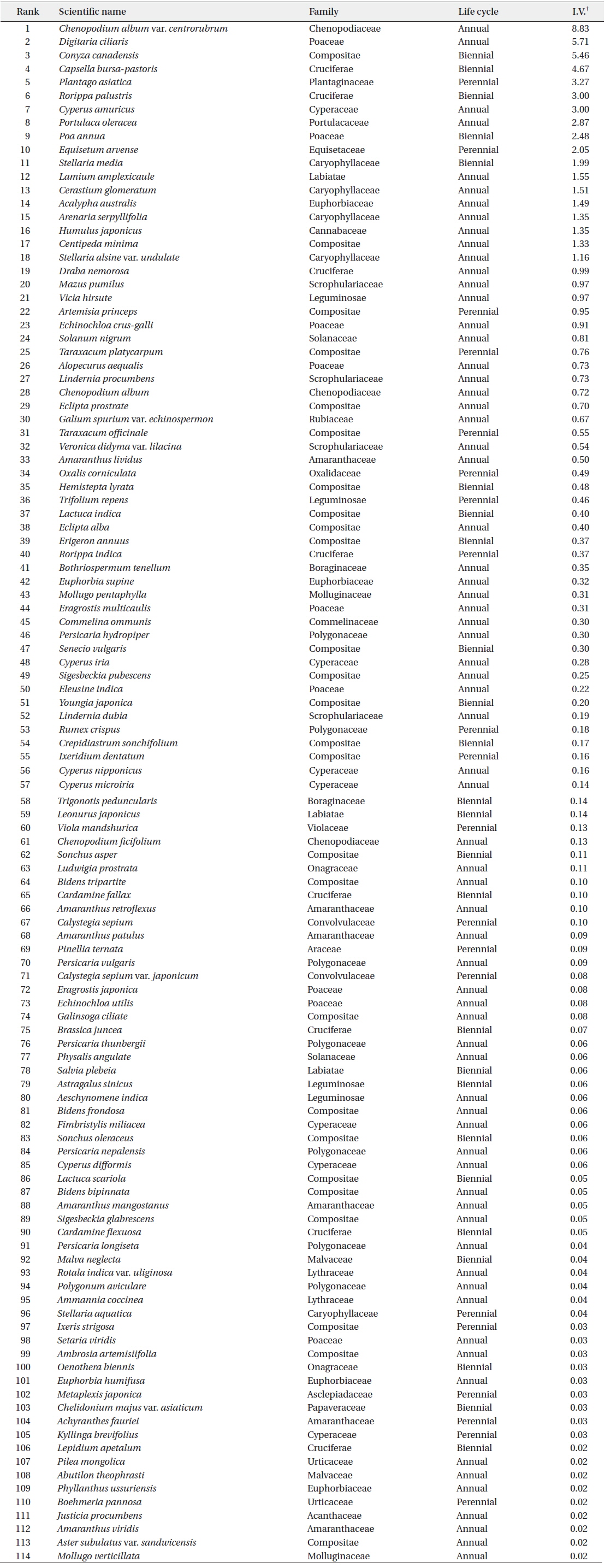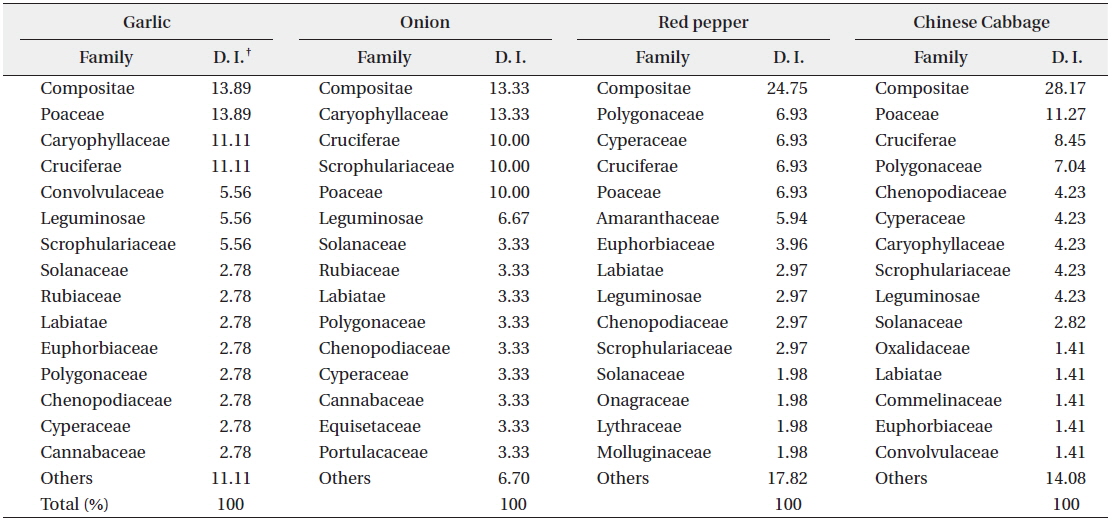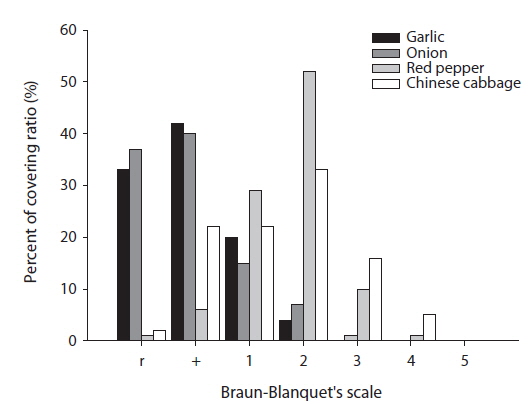



Due to an increase in income from rapid growth of the economy, there have been enormous changes in the consumption pattern of agricultural products. Consumption of food has been steadily changing from starchy food, especially grains, to foods that are high in protein and vitamin contents (Jeong 2000). With the increasing awareness in the quality of life, there has been an upsurge in the demand for safe food, leading to changes in agricultural practices towards more environment friendly farming, which is safer for humans and animals. Particularly, there has been much focus on the safety and environmental hazards of herbicides used to manage weeds that grow during the cultivation of crops.
In agriculture, weeds may play some roles, providing diversity, ecosystem functions and supporting many other species such as insects and birds (Marshall et al. 2003). It is ecologically meaningful data to understand the weed species diversity of agricultural land because the same weeds can occur in different growing conditions such as upland, orchard and pasture.
The occurrence of weeds in a crop field means an increase in the density of plants in a limited area. Consequently, the presence of weeds in a field, with a planting density designed to yield the maximum amount of crops, would inevitably decrease the average crop yield (Won et al. 2011). The decrease in crop yield could range from 30 to 100 percent, depending on weed management. Along with a decrease in their quantity, the weeds also bring a decline in the crop quality. Depending on the type of crop, a variety of preventative measures, including the use of herbicides, are applied to manage weed occurrence in agricultural land. Along with herbicide use, vinyl mulching, rice and barley straw, and hand weeding are also used to manage weed occurrence (Lee et al. 2001). Before weed growth begins, pesticides are applied for soil treatment, while mulching, nonselective herbicides in furrows, and hand weeding are usually employed during the cultivation period.
In the Chungnam province, there is an increase in garlic and onion fields, but a decrease in number of red pepper and Chinese cabbage fields. Red pepper is the number one crop in Korea in terms of cultivation area and yield production. However, in 2013, in the Chungnam region, the cultivated area decreased by 29.9%, from 6,572 ha in 2005 to 1,968 ha (KOSTAT 2013). The reason for this decrease could be the requirement of a substantial amount of labor, and the difficulty to mechanize transplanting and harvesting processes. Therefore, it is necessary to use herbicides due to the fact that agricultural population is declining and rapidly aging.
Weed development is influenced by the region’s landform, soil property, and types of industry. Weed vegetation in agricultural land has changed depending on cropping patterns and weed control methods. Improved crop management techniques, including herbicides, have resulted in good control of weeds and have facilitated different cropping patterns and steadily increasing crop yields (Marshall et al. 2003). The change in herbicide is the main cause of changes in the diversity, amount of weed development, and dominant weed species within an agricultural ecosystem (Kim and Shin 2007). A successive application of the same herbicide has the most direct influence on the change in the community of weeds that develop in crop fields (Kim et al. 2012).
To effectively manage weeds that grow in crop fields and to prepare measures against the changes in weed community, it is important to understand the weed species and their distribution. Botanically, weeds are divided into pteridophytes and spermatophytes. Spermatophytes are further divided into dicotyledones and monocotyledons, with further divisions into different families. Weeds are also classified as grassy weeds, broadleaf weeds, and sedge weeds. Based on their life cycles, they could be either annual weeds or perennial weeds. This practical classification is meaningful in the selection of herbicides, since each group has a similar response to herbicides (Rural Development Administration 2000).
In Korea, since dry field crops are usually cultivated in small areas, there have been fewer studies on controlling weeds growing in dry fields, as compared to studies for weeds in rice fields. Systematic studies on weeds growing in dry fields only started after 1980 (Im et al. 2008). In a five year period starting from 2000, Lee et al. (2007) studied the distribution of weeds growing on cultivated land, and reported that there are 302 species of weeds in dry fields, including 30 major weed species in Korea.
The ultimate goal of managing weeds is effective weed control, and therefore it is essential to understand the occurrence and the distribution of weeds that grow in crop fields. Studying the distribution of weeds would enable a systematic construction of weed management system by continuously providing the current state of weed growth. If problematic weeds and foreign weeds are identified, suitable preventative measures can be applied, and we could hope for an improvement in both quality and quantity of crops, as well as saving of labor.
This study, conducted every ten years by the rural development administration (RDA) as a part of the nationwide-detailed distribution analysis of weed development in cultivated lands, was undertaken to retain basic data that would enable the development of effective laborsaving weed control technology by understanding the distribution patterns of weeds and the extent of damage they have on major horticultural crops grown in the Chungnam province.
This study was conducted from April to October of 2014 (garlic and onion: April-May, red pepper: July-August, and Chinese cabbage: October), to confirm the development patterns and the changes in distribution of weeds that grow on crop fields of major horticultural crops in 17 cities and guns (districts) of Chungnam region, including Daejeon and Sejong.
The target crop fields were horticultural crop fields with little to no preventive measures against weeds; they were randomly selected from eup or myeon belonging to each city and gun, that were divided according to administrative districts. The frequency and distribution of weed growth were investigated in each survey site. To understand the changes in the weed community in same crop fields, we used Hi Drive ver. 2.0 (a smartphone application) to record GPS (ICE CPS 100c) information and address. The area of each crop field was roughly measured by counting how many steps it takes a researcher to get from one end to the other. The weed development and the area surrounding the fields were photographed (Canon 100D). Weed species were identified with visual assessment, and the covering ratio was studied based on the 7-level system (5, 4, 3, 2, 1, + and r) of Braun-Blanquet (1964). The cover-abundance index used by Braun-Blanquet is as follows: 5, covering more than 75% of the whole target fields; 4, any number of individuals covering 50-75% of the area; 3, any number of individuals covering 25-50% of the area; 2, very numerous or covering at least 5% of the area; 1, plentiful but of small cover value; +, sparsely present, cover small; r, very sparsely present, cover very small (Poore 1955).
To figure out the dominant species based on the results, we analyzed the importance value (Curtis and McIntosh 1950). Frequency, defined as the percentage of samples where certain species appear among all the crop fields under observation, was calculated by dividing the number of crop fields with a certain species, by the number of all the crop fields. Relative frequency (RF) was calculated by dividing frequency by the sum of frequencies of all the species multiplied by 100. Relative cover (RC) was calculated by dividing the cover degree (a value found by dividing the area that a certain species occupies by the area of the enumeration district) by sum of the cover degree of all the species multiplied by 100. Importance value (IV) was calculated by adding the relative frequency and the relative cover degree and dividing the results in half.
The results from the weed survey were compiled into lists, in accordance with the Synonymic List of Vascular Plant of Korea (Korea National Arboretum 2007). Exotic weeds were recorded using “Colored Illustrations of Naturalized Plants of Korea (Park 2009) as a reference. For the confirmed species of weeds, we classified them into annual, biennial and perennial weeds, based on life cycles presented by Raunkiaer (1934), and then calculated the distribution proportion of each family of weeds.
The species and the distribution patterns of weeds in the 516 crop fields (82 for red pepper, 285 for garlic, 86 for onion, and 63 for Chinese cabbage) of Chungnam province were analyzed (Table 1), there were a total of 32 weed families, comprised of 114 species. There were 69 species of annual weeds, 25 species of biennial weeds, and 22 species of perennial weeds, which comprised 61%, 22%, and 18% of the total, respectively (Table 2). The most dominant weed in the Chungnam region was
[Table 1.] The number of survey sites at each location of Chungnam province in Korea

The number of survey sites at each location of Chungnam province in Korea
[Table 2.] Occurrence of weed species on horticulture fields in Chungnam province

Occurrence of weed species on horticulture fields in Chungnam province
The analysis of importance values in each cultivated crop showed differences in number of weed species and their dominant weed species. However, similar weed species and number of weeds were identified on the crop fields around the same survey time. In the winter crop fields,

Importance values of top 10 weed species on garlic, onion, red pepper and Chinese cabbage fields

Dominant index of weed species occurred in garlic, onion, red pepper and Chinese cabbage fields classified by families
In terms of types of crop, 71 species belonging to 25 families were found in Chinese cabbage fields, 36 species belonging to 20 families were found in garlic fields, 30 species belonging to 17 families were found in onion fields, and 101 species belonging to 30 families were found in red pepper fields. Generally, weed occurrence surveys show an increasing trend of weed species as the number of fields analyzed are increased. However, in this study, there were more species of weeds identified in red pepper fields and Chinese cabbage fields, but which were lower in numbers than in garlic fields and onion fields. Also, according to the dominance value analysis by Braun-Blanquet, about 43% of garlic fields and 39% of onion fields had dominance value + (weed occurrence is below 5% of the fields surveyed), showing low weed occurrence frequency. About 53% of red pepper fields and about 34% of Chinese cabbage fields had dominance value 2 (weed occurrence is between 5 and 25%), showing a relatively high weed occurrence frequency. This is probably due to the differences in survey periods, which leads to differences in weed types, along with the fact that since garlic and onion are local indigenous products of the Chungnam region, a systematic and continuous weed control is put into place during the growing period of the crops (Fig. 1). Generally, during the cultivation period, weed management is done with nonselective herbicides being treated in the furrows along with hand weeding; any lack of weed management results in the weeds to flourish. Therefore, the fact that we performed this study in summertime when weed growth is vigorous, seems to be the reason that the dominance values of red pepper fields and Chinese cabbage fields are shown to be high.
In addition,




